Way Out West (1937)
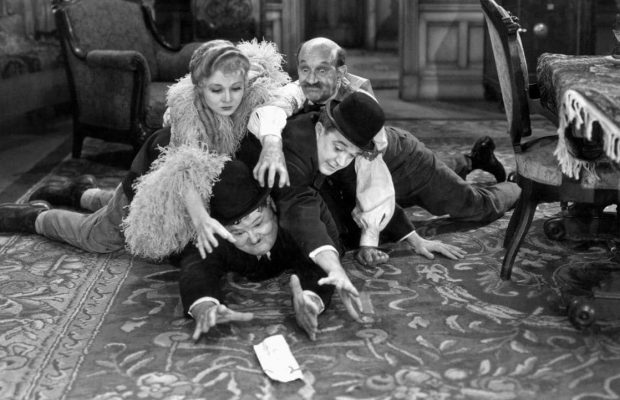
Toronto Film Society presented Way Out West (1937) on Monday, August 14, 1967 as part of the Season 19 Summer Series “Thirties to Forties”, Programme 4.
An Evening with Laurel and Hardy
This evening is devoted to the work of Stan Laurel and Oliver Hardy. They were two of the most genuinely funny people who ever lived and as a team have never been equalled. They did not follow the pattern of comedian and straight man. Each had his own highly individual comedy style and these styles meshed miraculously. Laurel was a great influence on the directing of their movies (he had been a director before teaming with Hardy) and had a unique concept of comedy production. He was responsible for their movies being usually shot in sequence, so that comedy could be allowed to build naturally, and he also supervised the editing in most cases as well as writing or devising many of the gags and situations they used.
The Second Hundred Years USA 1927 Silent 20 mins b&w 16mm
Production Company: Hal Roach Studios. Producer: Hal Roach. Director: Fred L. Guiol. Titles: H.M. Walker.
Cast: Stan Laurel, Oliver Hardy, James Finlayson, S.J. Stanford.
This is one of the earliest of the Laurel-and-Hardys, being only the third to be produced in which they were billed as a team.
Double Whoopee USA 1929 Sound 20 mins b&w 16mm
Production Company: Hal Roach Studios. Producer: Hal Roach. Director: Lewis R. Foster. Story: Leo McCarey. Editor: Richard Currier.
Cast: Stan Laurel, Oliver Hardy, Jean Harlow, Charlie Hall.
Of all the great comedians of the silent era, Laurel and Hardy unquestionably made the most successful transition into sound. The quality of their pictures showed no decline and they utilized sound for all it was worth–but as a tool, never as a master. This was only their second sound movie, but there is no tentativeness in the style, none of the tendency to run off at the mouth that was so common in this period. (Placed 21st in the international critics’ poll.)
Big Business USA 1929 Sound 25 mins b&w 16mm
Production Company: Hal Roach Studios. Producer: Hal Roach. Director: James Wesley Horne. Supervision and Story: Leo McCarey. Photography: George Stevens. Editor: Richard Currier. Titles: H.M. Walker.
Cast: Stan Laurel, Oliver Hardy, James Finlayson.
This was the very next movie they made after Double Whoopee. They decided to shoot this one on location–and just about demolished the location! Jimmy Finlayson does a virtuoso version of his famous “double-take and fade away” in which he literally knocked himself out by hitting his head against the door frame. (Placed 16th in the international critics’ poll.)
Notes by Ron R. Anger
– Intermission 10 minutes –
Way Out West (1937)
A Stan Laurel Production. Production Company: Hal Roach Studios. Releasing Company: Metro-Goldwyn-Mayer. Director: James Wesley Horne. Original Story: Jack Jeyne and Charles Rogers. Screenplay: Charles Rogers, Felix Adler and James Parrott. Photography: Art Lloyd and Walter Lundin. Editor: Bert Jordan. Art Director: Arthur I. Royce. Settings: W.L. Stevens. Photographic Effects: Roy Seawright. Musical Director: Marvin Hatley. Sound: William Randall.
Cast: Stan Laurel and Oliver Hardy (themselves), Sharon Lynne (Lola Marcel, the Bad Girl), James Finlayson (Mickey Finn, the saloon owner), Rosina Lawrence (Mary Roberts, the Good Girl), Stanley Fields (the Sheriff), Vivian Oakland (the Sheriff’s wife), The Avalon Boys (themselves).
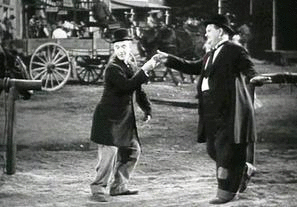
Arthur Stanley Jefferson, or Stan Laurel as he was later to be known, began his career in English music halls in 1907. The son of a prominent showman, he was only sixteen when he joined the legendary Fred Karno troupe of vaudeville artists. While with Karno, Stan appeared in “Mumming Birds”, a pure story-pantomime that is fondly remembered by vaudeville veterans on both sides of the Atlantic Ocean. Some refer to it as the greatest ensemble act of the century. One reason for this acclaim may have been the presence of Charlie Chaplin in the role of the drunk. However, another reason may have been the performances of Chaplin’s understudy, who was to become famous in Hollywood as the physically thinner half of the great comedy team Laurel and Hardy.
The physically larger half of this lovable team was born in Harlem, Georgia, USA, in 1892. Oliver Norvell Hardy was the son of a lawyer and, unlike Stan Laurel, a member of a non-show business family. As a boy his hobby of watching people in hotel lobbies may have supplied him with many of the characterizations that occur in his films. An early enthusiasm for music led him, while only eight years old, to tour as a soprano with a group called Coburn’s Minstrels. Much later he studied at the Atlanta Conservatory of Music and, for a brief period, law at the University of Georgia. In 1910 he opened the first movie theatre in Milledgeville, Georgia, and became more than interested in motion pictures. This fascination with movies led to employment as a “heavy” in comedies produced by Lubin Motion Pictures at Jacksonville, Florida, in 1913.
Stan Laurel, who had been working the American vaudeville circuits for several years, made his first film in 1917. Both Stan and Oliver worked separately in Hollywood until 1926, when they were paired together rather accidentally in the Hal Roach short Slipping Wives. In the same year* the first Laurel and Hardy film was produced, entitled Putting Pants on Philip. Altogether the Laurel and Hardy short films, both silent and talkies, totalled more than sixty. In addition the boys appeared in twenty-seven feature-length films. The last, and least fondly remembered by many people, was made in France in 1952.
Some reviewers regard the years between 1936 and 1940 as the artistic peak for the feature-length films. Among these titles are: Our Relations (1936), Blockheads (1938), A Chump at Oxford (1940), Saps at Sea (1940), and tonight’s film Way Out West (1937), which just might be the best Western ever made.
Notes by Robert McMillan
*Other reliable authorities give the date of Putting Pants on Philip as 1928.
_______________________________________________________________________
Erratum: In The Fatal Glass of Beer (shown August 3), “Richard Krymar” should be Rychard Cramer.

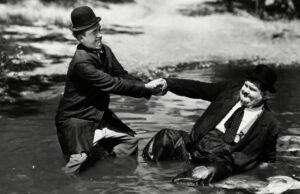
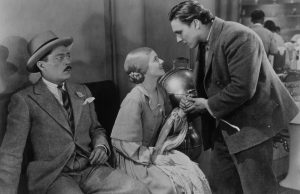
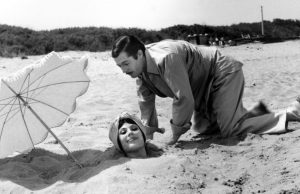






Leave a Reply